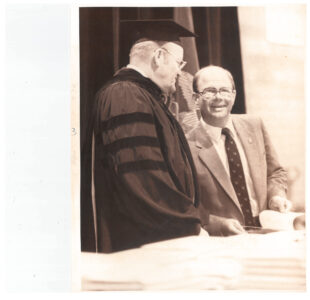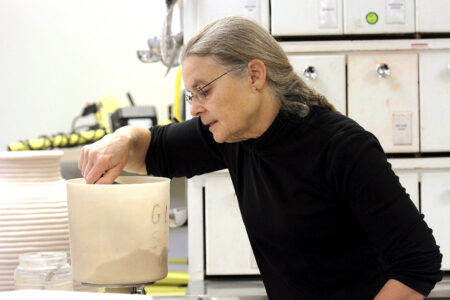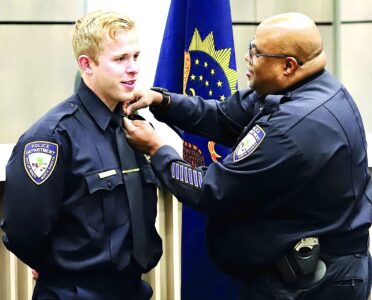Dakota Datebook May15-19
Bobcat traces roots to Northern Prairies
By LANE SUNWALL
May 15 — On this day, May 15, 2006, the Ingersoll-Rand Company announced plans to sell off its Bobcat machinery division. Bobcat’s parent company was hoping to move out of the construction machinery business but was willing to wait for the right offer. The “right” offer came three months later from the South Korean firm Doosan Infracore, which bought Bobcat for a total of $4.9 billion.
Although it grew into a multi-billion-dollar company, Bobcat can trace its roots to the Northern Prairies and two innovative brothers from Minnesota. In 1956, Eddie Velo presented Cy and Louis Keller with a rather pressing problem. He needed to clean manure from the small corners of his turkey barns, but all of his power equipment was too large to effectively operate in his small buildings. Furthermore, his barns had two stories, so not only did a new cleaner need to be small and maneuverable; it needed to be lightweight. The Keller brothers went to work.
After scraping through the junkyard and the surrounding community for parts, they soon assembled a new cleaner for the turkey farmer. The machine was an instant success. It was agile, able to turn 360 degrees in its own track and had a good scoop, able to quickly clean anything Velo’s turkeys could throw at it.
It didn’t take long for the Keller brothers to realize their new invention had uses beyond a turkey farm. Seeing potential in this new small scoop machine, the Keller’s uncle, Anton Christianson, contacted Les Melroe of Melroe Manufacturing, based in Gwinner. Melroe was impressed with the new invention. After a short time he bought the rights to produce the small loader and hired Cy and Louis to further develop their invention.
Three years later, the Keller brothers, working alongside Les’s brother Cliff Melroe, had greatly improved their machine.
They developed a four-wheeled, skid-steered loader, big enough to handle a wide variety of jobs, yet small enough to fit in the back of a pickup. The Bobcat was thus born and the new invention moved Melroe Manufacturing into the construction industry, greatly expanding the company in the process. By 1967 the North Dakota-based business was shipping Bobcats to Australia, and had established a European branch in Southampton England, pushing Melroe Manufacturing’s sales to $16.5 million a year.
A tree grows in Washington
By SARAH WALKER
May 16 — Did you know that in the 1950s, there was a little bit of North Dakota growing in Washington, D.C.?
On this day in 1953, The Minot Daily News proudly published a photo it had received of several residents of North Dakota standing in front of North Dakota’s state tree, the American elm, in front of the Capitol building in Washington.
This tree was planted by residents of the state. It was dedicated the year before, in 1952, to commemorate the 50th anniversary of the signing of the reclamation act by Theodore Roosevelt.
Roosevelt was a conservationist. He was known for his hunting, his love of the outdoors. In his political career, among other agenda, he established the National Wildlife Refuge program and had some responsibility for establishing federal control and regulation over public lands of the West. He created many national parks and monuments, including, of course, the Grand Canyon, Mesa Verde, Montezuma’s Castle and Petrified Forest.
The National Reclamation Act of 1902 gave authorization to western irrigation projects which were to be paid for by the sale of land in 16 semiarid states. Under this act, he was able to initiate construction of western dams, and was able to start to reclaim the desert Southwest. So a tree was a suitable memorial.
Also, in another aspect, this tree honored George Washington. The Minot Daily News reported that this little American elm was planted in the same place that George Washington himself once planted a tree. North Dakota sought and received permission to plant that North Dakota tree on the same site after the tree’s old age caught up with it and it died.
Custer’s Farewell
By CHRISTINA SUNWALL
May 17 — On this day, May 17, 1876, Lieutenant Colonel George Armstrong Custer and the 7th Cavalry set out from Fort Abraham Lincoln on the expedition that would meet its fateful end at the Little Bighorn.
Elizabeth Custer and her sister-in-law, Margaret, accompanied the regiment as far as the Heart River, returning to the fort the next day with the paymaster. It was the last time Libby saw her husband alive.
Of the farewell, Mrs. Custer wrote, “With my husband’s departure my last happy days in garrison were ended, as a premonition of disaster that I had never known before weighed me down. I could not shake off the baleful influence of depressing thoughts. This presentiment and suspense, such as I had never known, made me selfish, and I shut into my heart the most uncontrollable anxiety, and could lighten no one else’s burden.”
Senator Porter McCumber
By CHRISTINA SUNWALL
May 18 — Senator Porter McCumber of North Dakota was born in Crete, Illinois, in 1858. Following his graduation from the University of Michigan, McCumber moved to Wahpeton, Dakota Territory, in 1881 to practice law. After several years in the Dakota Territorial Legislature, he was eventually elected as a Republican to the United States Senate in 1899.
While representing North Dakota, Senator McCumber proved influential in many key areas. He presented a bill in the Senate that eventually became the 1906 Pure Food and Drug Act. Following World War I, he was the most outspoken advocate for the League of Nations among the Republican senators and as chairman of the finance committee, he played a leading role in the creation of the Fordney-McCumber Tariff Act of 1922.
After representing North Dakota for 23 years in the U.S. Senate, Porter J. McCumber passed away on this day, May 18, 1933.
Buffalo Bill’s Wild West Show
May 19 — On this day in 1883, Buffalo Bill’s Wild West show held its first public performance in Omaha, Nebraska. For the next three decades, the massive outdoor show traveled across the United States, Great Britain and Europe staging reenactments of life on the American West such as the Bison Hunt, the Train Robbery and the Attack on the Burning Cabin.
Performers included Mexicans, African-Americans, Native Americans, cowboys, women and children, along with experts in shooting, lassoing and riding.
Of course, no showcase of the West would be complete without the addition of some of North Dakota’s most famous and talented residents.
Sitting Bull traveled with the Wild West show for a short time in 1885, earning $50 a week for riding once around the arena, in addition to whatever he could charge for his autograph and picture.
Scott Byron Gore, a rancher near Grassy Butte, became a nationally recognized saddle bronc rider, having ridden in Buffalo Bill’s Wild West Show in Europe. George Gardner of Medora, another bronc rider and trick and fancy rope performer, along with his friend and fellow North Dakotan “Badlands Bill” McCarty, also traveled with the Wild West Show.
The two most nationally recognized former residents of northern Dakota Territory did not appear personally in the show, but their portrayal played a starring role in the performances. The Battle of Little Big Horn was an obvious event for a Wild West reenactment and by 1888, Custer’s Last Stand had become a regular feature. The character of Theodore Roosevelt was added to the show following the Spanish-American War. By 1899, the Battle of San Juan Hill had replaced “Custer’s Last Stand” as the grand finale.
For many of the North Dakotans who participated or were portrayed in the show, Buffalo Bill’s Wild West performances opened new doors and opportunities. While on tour with the show, Sitting Bull shook hands with President Grover Cleveland, which he took as evidence that he was still regarded as a great chief. George Gardner and “Badlands Bill” McCarty, after leaving the Wild West Show, started their own traveling rodeo show. General Custer’s widow, Elizabeth, who witnessed the Last Battle reenactment performed in 1888, wrote to Cody appreciatively, describing her emotional reaction to it as ‘terrible’ realism. As for Theodore Roosevelt, the show boosted his status as a hero, keeping his military exploits vividly before the public as he ran for the vice presidency in 1900.
“Dakota Datebook” is a radio series from Prairie Public in partnership with the State Historical Society of North Dakota and with funding from Humanities North Dakota.




